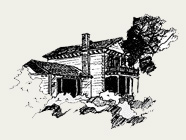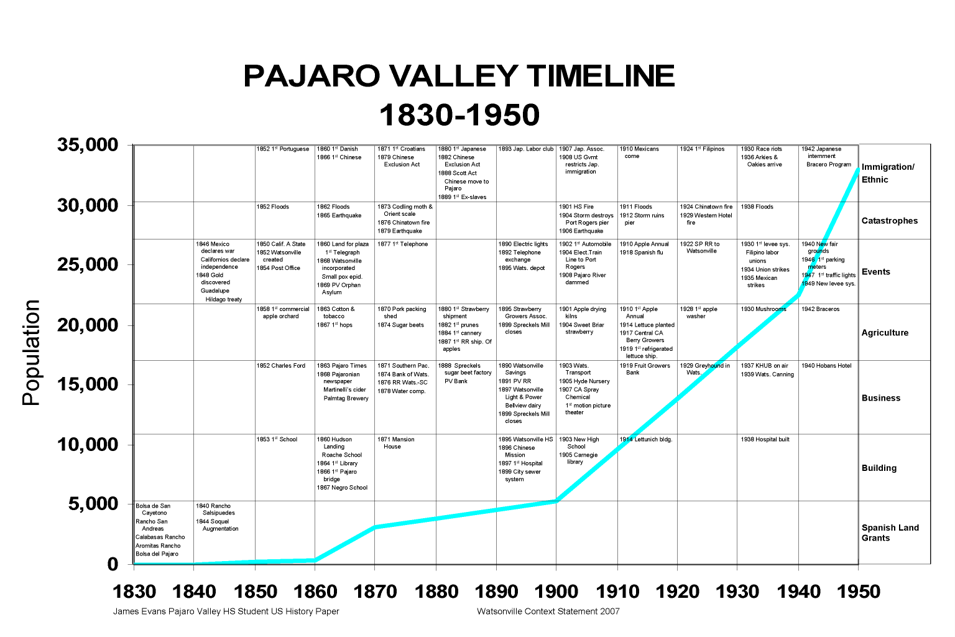For the last 170 years, the Pajaro Valley has been an opportunity for many different immigrants to improve themselves. Most came with a little except for the desire to make a better life for themselves and their families. The Pajaro Valley was a place where immigrants could realize the American dream.
Why has this been the case? Rich soil where almost anything can grow. Why rich soil? This year’s floods should be a clue. The floods bring new silt which deposits on top of the land.
Over tens of thousands of years it has built up the soil. A recent well drilling hit a buried redwood tree 250 feet down. That is some top soil layer.
So who came here and from where? We had the Spanish with the land grants, most probably Castilians, Irish, Chinese, Croatians, Japanese, Portuguese, Filipinos, and Mexicans, in all, 29 different ethnicities. There are 20 foreign languages spoken in our local schools. The ethnic mix changed over time as each group came.
Half of the people coming here were from other states in the United States along with some Canadians. Some immigrants came direct and some came through Hawaii where they worked on the plantations. The plantations had two year contracts and some of the Portuguese, Chinese, Japanese and Filipinos came through Hawaii. Some of these people continued on to California because they had relatives that were already here.
At the Pajaro Valley Historical Association, we looked at the 1860, 1870, 1900, and 1930 censuses. So let’s take a look at the growth over those 70 years and how much the mix changed.
In 1860 there were 3xx inhabitants; in 1870 it grew to 3xxx, a huge increase. In 1900 it grew some more with the Chinese, Japanese dominating the growth. The Pajaro Valley Chinatown was the second largest in the United States, second only to San Francisco. The largest group of Japanese was in the Monterey Bay. In the early 1900’s, the Filipinos and Mexicans came along with the Portuguese.
As each group came, they repeated the cycle that the previous groups experienced:
- They worked as manual laborers most often in farming,
- They would save some of their money, and buy a small plot of land, or they sharecropped, or they leased land, usually the worst land.
- They save some more money and bought better land and continue to increase their holdings.
- The exception was the Chinese, who became merchants or provided services such as dehydration of apples.
There were some racial issues with the Asians. Early on southern US immigrants wanted California to be a slave state and have the Asians be the slaves. This failed. Later they passed laws collectively known as the Asian Exclusion acts that prohibited land ownership and later to prohibit single Asian females from entering the US.
There were three mysterious fires in Chinatown and this lead to the Chinese leaving the area over time.
It’s tough to have much of a life if you have little or no females or can’t own land. Mr. Sakata, who came here when he was 14, had a clever idea. He formed a corporation with his American born children holding 51% and he and his wife holding 49%. That allowed them to buy land.
Then there were the photo brides and grooms. Local single Japanese men sent photos of themselves to their families in Japan and their families looked for perspective brides. If an arrangement could be made the couple was married in either a Japanese Shinto shrine, or a Buddhist temple. The new brides took a ship to San Francisco and met their new, grooms on the pier.
This was very clever, except for a few hiccups. Occasionally one or the other would use a photo of when they were younger, or from a friend who was better looking. So when the boat docked in San Francisco and the brides disembark, holding their photos and the grooms holding theirs, there were disconnects or surprises.
In 1930 there were race riots against the Filipinos and one man was killed. The single Filipino men would frequent the local dance halls and dance with the white women, angering local farmers. They also formed strike groups that also infuriated the local farmers.
In later years, the ethnic mix has seen some major changes. The Chinese and Japanese emphasized education and their children went off to college and mostly did not return. The Croatian’s and the Irish and other ethnic groups did not have that same drive for education so some went to college and some remained on the farm, taking over the family business at a later time. Some went to school and came back as lawyers, doctors and teachers.
Surprisingly, early on, there were very few Mexicans, and they did not come until the early part of the 20th century. When World War II broke out, the Pajaro Valley was faced with some major labor issues. Many of the Caucasian males were drafted, most of the Filipino men were also drafted, and the Japanese Americans were sent off to interment camps. That left a labor shortage for the farming, industry, which provided a great deal of the food for the country and our military. So, Mr. Driscoll and others worked with Washington to start the Bracero program to bring in Mexican laborers to work the fields during the war.
In order to ship the produce from the Pajaro Valley during the war, the railroads needed to be maintained. There was a shortage of labor to maintain the railroads. So women were enlisted to do that work. This was the Pajaro Valley equivalent of Rosie, the riveter.
This has been a capsule of the rich history of the Pajaro Valley.

